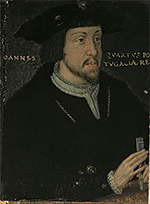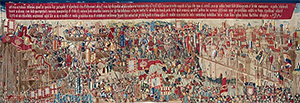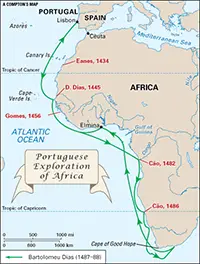King John II of Portugal
John II was King of Portugal for a decade and a half during the latter half of the 15th Century. He encouraged an expansion in his country's naval explorations and engineered one very famous world-changing treaty negotiation. 
He was born on March 3, 1455, in the Castle of São Jorge. His father was the reigning monarch, Afonso V, and his mother was Isabella of Coimbra. He was the king's oldest son and so was heir apparent. 
John (João) married Leonor of Viseu in 1471, when she was just 12 and he 15. That was a momentous year for the teenaged king-in-waiting in that he also gained his knighthood, fighting against the Moors in North Africa. He took part in King Afonso's conquest of Arzila and Tangier. In 1475, Afonso involved himself in Castilian politics, battling for the throne of that neighboring kingdom. John went, too, commanding a group of soldiers in his father's army. The effort was unsuccessful, and Afonso announced his abdication, leaving John as king on Nov. 10, 1477. The Cortes didn't accept the abdication and so when Afonso died, in 1481, he was technically still king. 
Afonso had given John the rights to the Guineas, in Africa, and the new king authorized an expedition in December 1481 to create a trading post in the Gulf of Guinea. This became Sãxzo Jorge da Mina, the first European colony in equatorial Africa. The resulting gold traffic back to Lisbon enriched John's holdings and financed new expeditions. Diogo Cão in 1482 sought the southern tip of Africa but didn't reach it, settling for seeing the impressive Congo River instead. It was in 1488 that Bartolomeu Dias rounded the Cape of Good Hope, reaching the southeasternmost tip of the continent before turning back because of a lack of supplies. In 1484, King John listened patiently to a presentation by a Genoese sailor named Christopher Columbus, who proposed to reach the east by going west. John and his ministers rejected Columbus's mathematics and his plan, concluding (correctly, as it turned out) that the Italian's figures were wrong. It was to Lisbon that Columbus returned, however, when he came back to Europe after That turned out to be John's last famous act. He got sick in October 1495 and died within a few days. He and Leonor had had a son, Afonso, whom they hoped would be the next king. The boy died in a horse riding accident in 1491. John had another son, Jorge, whose mother was not Leonor, and John wanted to name this other son as his successor. He found no support for the move, however, and, in 1493, named to succeed him his cousin, who became King Manuel I.
|
|
Social Studies for Kids
copyright 2002–2026
David White



 his first voyage to the New World. He washed up on Portuguese soil after a storm and reported to King John his findings and experiences. The king's response was to claim whatever Columbus had found for himself, under the terms of a previous treaty made with Spain. When Columbus then made his way to the Spanish court, the monarchs there,
his first voyage to the New World. He washed up on Portuguese soil after a storm and reported to King John his findings and experiences. The king's response was to claim whatever Columbus had found for himself, under the terms of a previous treaty made with Spain. When Columbus then made his way to the Spanish court, the monarchs there, 
